Abstract
The nervous system of the nematode worm Ascaris contains about 250 nerve cells; of these, the motoneurons consist of five segmental sets, each containing 11 cells. Morphologically, the motoneurons can be divided into seven different types. Their geometry is simple: some are unbranched, others have one branch point, and the most complex have two. There is no neuropil in the nerve cords; synapses are made by axo-axonal contact or onto short spines. These features enable us to study the anatomy and physiology of the system with a degree of completeness that would be difficult in other systems. The physiological activity of five of the motoneurons has been investigated, three being excitatory and two inhibitory. The excitatory motoneurons receive input from intersegmental interneurons. The inhibitory motoneurons do not receive input from the interneurons; instead they receive their input from the excitatory motoneurons in a circuit that can mediate reciprocal inhibition between the dorsal and the ventral musculature.
Full text
PDF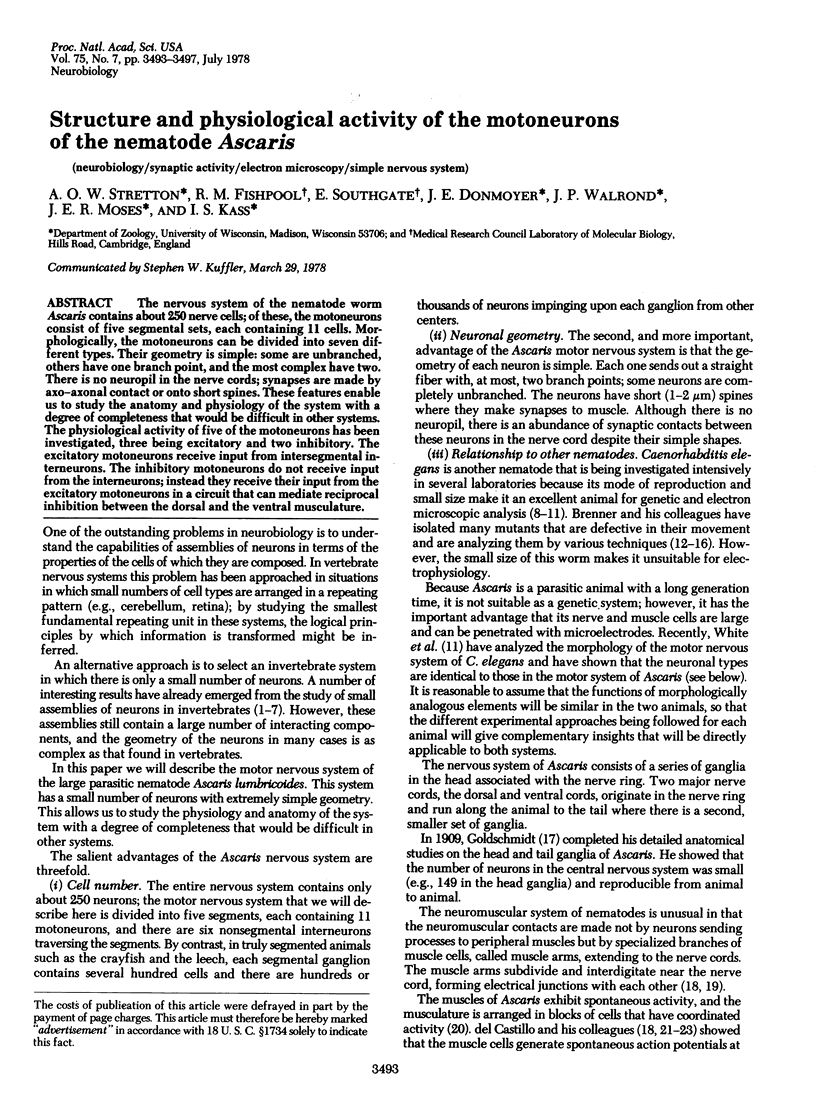
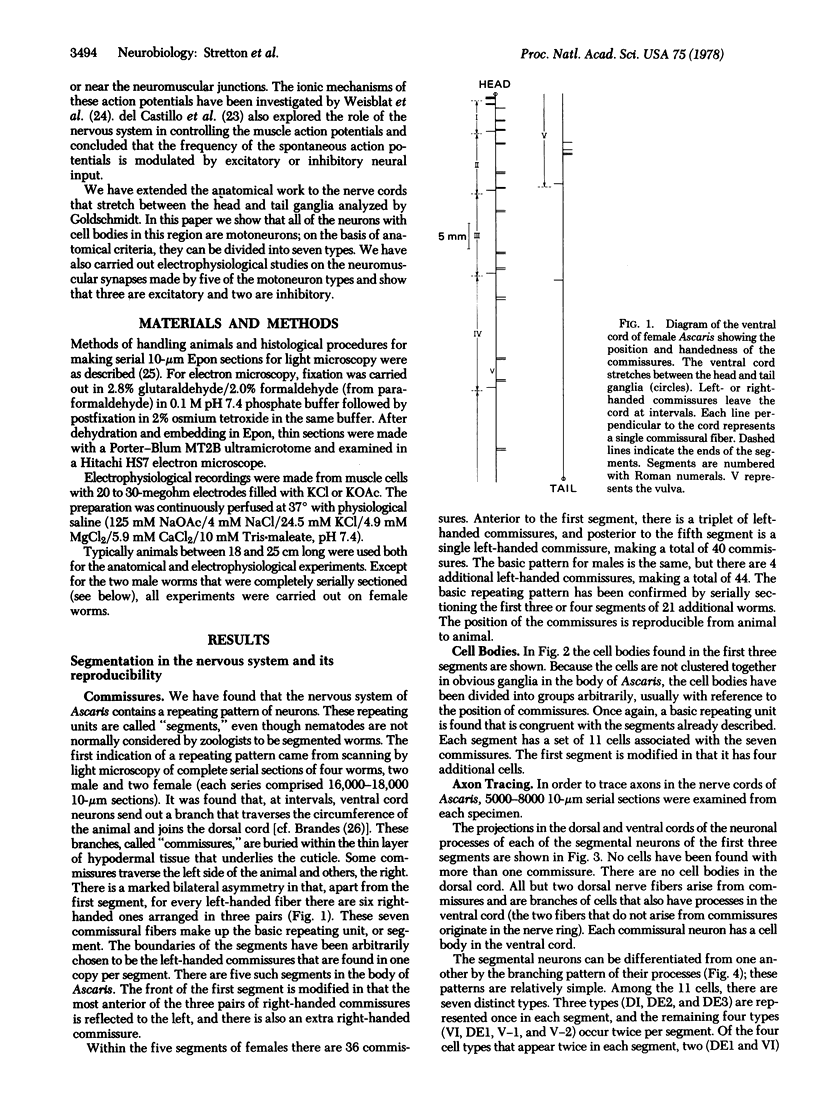
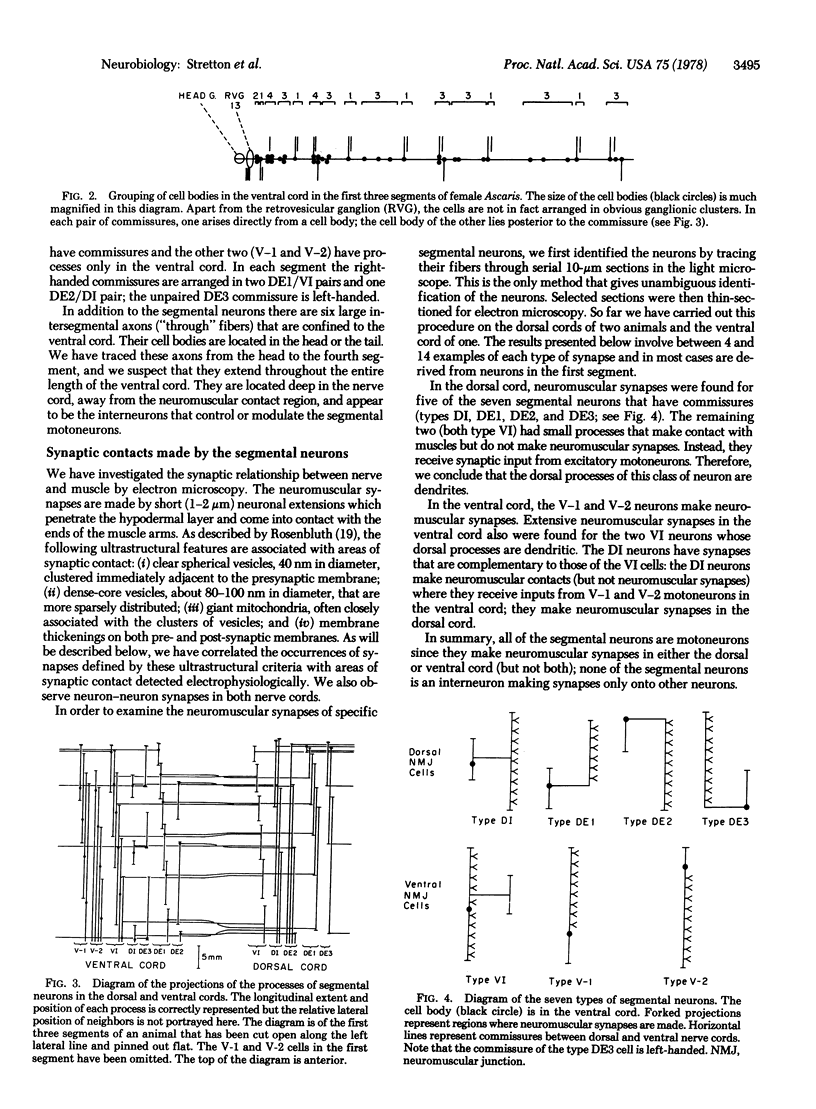
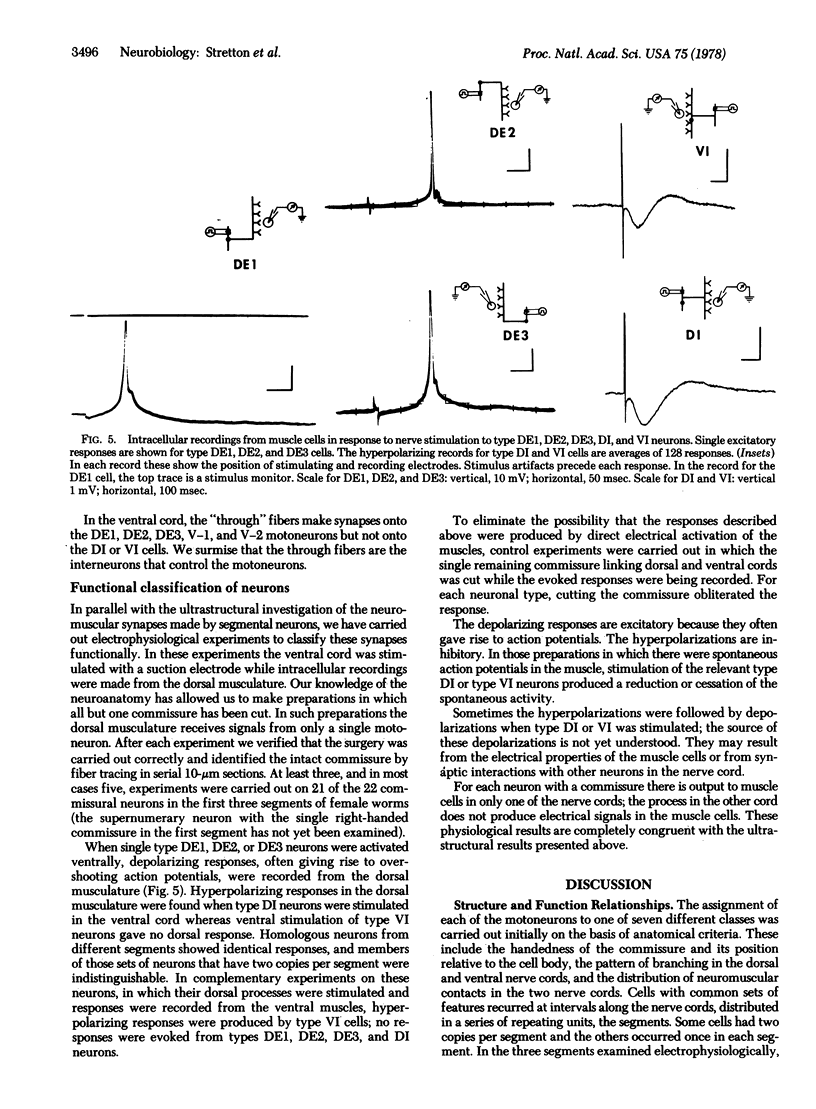
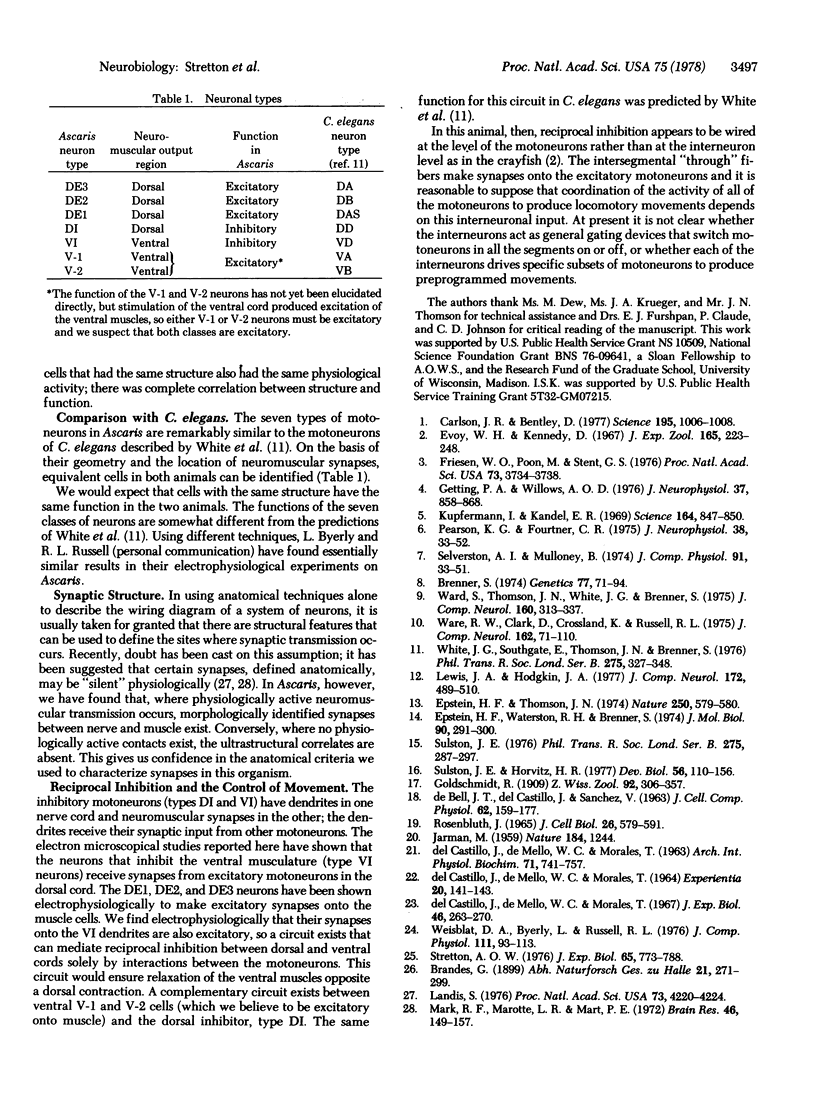
Selected References
These references are in PubMed. This may not be the complete list of references from this article.
- Brenner S. The genetics of Caenorhabditis elegans. Genetics. 1974 May;77(1):71–94. doi: 10.1093/genetics/77.1.71. [DOI] [PMC free article] [PubMed] [Google Scholar]
- Carlson J. R., Bentley D. Ecdysis: neural orchestration of a complex behavioral performance. Science. 1977 Mar 11;195(4282):1006–1008. doi: 10.1126/science.841322. [DOI] [PubMed] [Google Scholar]
- DELCASTILLO J., DEMELLO W. C., MORALES T. THE PHYSIOLOGICAL ROLE OF ACETYLCHOLINE IN THE NEUROMUSCULAR SYSTEM OF ASCARIS LUMBRICOIDES. Arch Int Physiol Biochim. 1963 Nov;71:741–757. [PubMed] [Google Scholar]
- Del Castillo J., De Mello W. C., Morales T. Inhibitory action of gamma-aminobutyric acid (GABA) on Ascaris muscle. Experientia. 1964 Mar 15;20(3):141–143. doi: 10.1007/BF02150701. [DOI] [PubMed] [Google Scholar]
- Del Castillo J., De Mello W. C., Morales T. The initiation of action potentials in the somatic musculature of Ascaris lumbricoides. J Exp Biol. 1967 Apr;46(2):263–279. doi: 10.1242/jeb.46.2.263. [DOI] [PubMed] [Google Scholar]
- Epstein H. F., Thomson J. N. Temperature-sensitive mutation affecting myofilament assembly in Caenorhabditis elegans. Nature. 1974 Aug 16;250(467):579–580. doi: 10.1038/250579a0. [DOI] [PubMed] [Google Scholar]
- Epstein H. F., Waterston R. H., Brenner S. A mutant affecting the heavy chain of myosin in Caenorhabditis elegans. J Mol Biol. 1974 Dec 5;90(2):291–300. doi: 10.1016/0022-2836(74)90374-x. [DOI] [PubMed] [Google Scholar]
- Friesen W. O., Poon M., Stent G. S. An oscillatory neuronal circuit generating a locomotory rhythm. Proc Natl Acad Sci U S A. 1976 Oct;73(10):3734–3738. doi: 10.1073/pnas.73.10.3734. [DOI] [PMC free article] [PubMed] [Google Scholar]
- Getting P. A., Willows A. O. Modification of neuron properties by electrotonic synapses. II. Burst formation by electrotonic synapses. J Neurophysiol. 1974 Sep;37(5):858–868. doi: 10.1152/jn.1974.37.5.858. [DOI] [PubMed] [Google Scholar]
- JARMAN M. Electrical activity in the muscle cells of Ascaris lumbricoides. Nature. 1959 Oct 17;184(Suppl 16):1244–1244. doi: 10.1038/1841244a0. [DOI] [PubMed] [Google Scholar]
- Kupfermann I., Kandel E. R. Neuronal controls of a behavioral response mediated by the abdominal ganglion of Aplysia. Science. 1969 May 16;164(3881):847–850. doi: 10.1126/science.164.3881.847. [DOI] [PubMed] [Google Scholar]
- Landis S. C. Rat sympathetic neurons and cardiac myocytes developing in microcultures: correlation of the fine structure of endings with neurotransmitter function in single neurons. Proc Natl Acad Sci U S A. 1976 Nov;73(11):4220–4224. doi: 10.1073/pnas.73.11.4220. [DOI] [PMC free article] [PubMed] [Google Scholar]
- Lewis J. A., Hodgkin J. A. Specific neuroanatomical changes in chemosensory mutants of the nematode Caenorhabditis elegans. J Comp Neurol. 1977 Apr 1;172(3):489–510. doi: 10.1002/cne.901720306. [DOI] [PubMed] [Google Scholar]
- Mark R. F., Marotte L. R., Mart P. E. The mechanism of selective reinnervation of fish eye muscles. IV. Identification of repressed synapses. Brain Res. 1972 Nov 13;46:149–157. doi: 10.1016/0006-8993(72)90012-1. [DOI] [PubMed] [Google Scholar]
- Pearson K. G., Fourtner C. R. Nonspiking interneurons in walking system of the cockroach. J Neurophysiol. 1975 Jan;38(1):33–52. doi: 10.1152/jn.1975.38.1.33. [DOI] [PubMed] [Google Scholar]
- Rosenbluth J. Ultrastructure of somatic muscle cells in Ascaris lumbricoides. II. Intermuscular junctions, neuromuscular junctions, and glycogen stores. J Cell Biol. 1965 Aug;26(2):579–591. doi: 10.1083/jcb.26.2.579. [DOI] [PMC free article] [PubMed] [Google Scholar]
- Stretton A. O. Anatomy and development of the somatic musculature of the nematode Ascaris. J Exp Biol. 1976 Jun;64(3):773–788. doi: 10.1242/jeb.64.3.773. [DOI] [PubMed] [Google Scholar]
- Sulston J. E., Horvitz H. R. Post-embryonic cell lineages of the nematode, Caenorhabditis elegans. Dev Biol. 1977 Mar;56(1):110–156. doi: 10.1016/0012-1606(77)90158-0. [DOI] [PubMed] [Google Scholar]
- Sulston J. E. Post-embryonic development in the ventral cord of Caenorhabditis elegans. Philos Trans R Soc Lond B Biol Sci. 1976 Aug 10;275(938):287–297. doi: 10.1098/rstb.1976.0084. [DOI] [PubMed] [Google Scholar]
- Ward S., Thomson N., White J. G., Brenner S. Electron microscopical reconstruction of the anterior sensory anatomy of the nematode Caenorhabditis elegans.?2UU. J Comp Neurol. 1975 Apr 1;160(3):313–337. doi: 10.1002/cne.901600305. [DOI] [PubMed] [Google Scholar]
- White J. G., Southgate E., Thomson J. N., Brenner S. The structure of the ventral nerve cord of Caenorhabditis elegans. Philos Trans R Soc Lond B Biol Sci. 1976 Aug 10;275(938):327–348. doi: 10.1098/rstb.1976.0086. [DOI] [PubMed] [Google Scholar]


